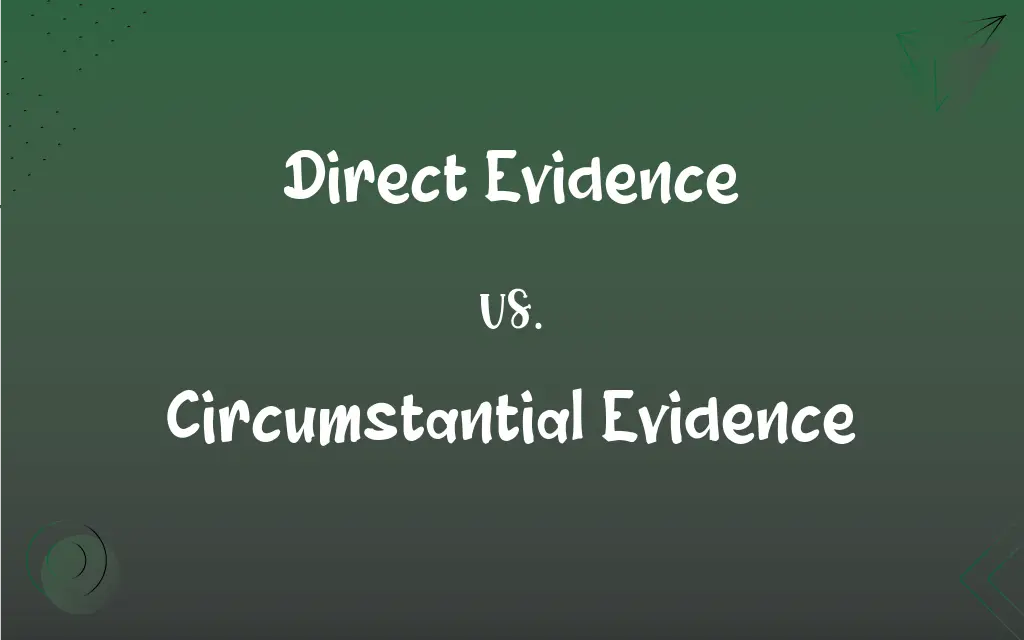Direct Evidence vs. Circumstantial Evidence: What's the Difference?
Edited by Aimie Carlson || By Janet White || Published on December 24, 2023
"Direct evidence proves a fact explicitly, like eyewitness testimony; circumstantial evidence implies a fact indirectly, like fingerprints at a crime scene."

Key Differences
Direct evidence directly links someone to a fact without needing inference, such as a video recording of a crime. Circumstantial evidence requires inference to connect it to a fact, like finding someone's belongings at a crime scene.
In legal settings, direct evidence is often considered more straightforward and convincing, such as testimony from someone who witnessed a crime. Circumstantial evidence, though sometimes seen as less persuasive, can be powerful, like DNA evidence linking a suspect to a crime.
Direct evidence typically stands on its own in proving a fact, like a confession in a criminal case. Circumstantial evidence often requires a combination of facts to build a case, such as a sequence of events leading up to a crime.
The reliability of direct evidence can depend on the credibility of the witness or source. The strength of circumstantial evidence often lies in its ability to corroborate with other evidence, forming a cohesive narrative.
In some cases, direct evidence is unavailable, and circumstantial evidence becomes crucial, such as using phone records to establish a suspect's location. Conversely, even strong circumstantial evidence might not be as compelling as direct testimony in certain cases.
ADVERTISEMENT
Comparison Chart
Nature of Proof
Explicit, straightforward
Indirect, requires inference
Examples
Eyewitness testimony, video recordings
Fingerprints, DNA evidence
Legal Strength
Often more convincing on its own
Powerful when corroborated
Dependency on Other Factors
Relies on source credibility
Strengthens with multiple pieces of evidence
Typical Use Cases
Clear-cut scenarios
Situations with no direct witnesses
ADVERTISEMENT
Direct Evidence and Circumstantial Evidence Definitions
Direct Evidence
Evidence that directly proves a fact.
The surveillance footage was direct evidence of the burglary.
Circumstantial Evidence
Evidence that implies a fact through an inference.
The suspect's fingerprints at the scene were circumstantial evidence.
Direct Evidence
Explicit proof without the need for assumption.
The defendant's confession was direct evidence of guilt.
Circumstantial Evidence
Indirect evidence suggesting a conclusion.
The discovery of the weapon nearby was circumstantial evidence.
Direct Evidence
Immediate evidence linking an individual to a fact.
The signed contract served as direct evidence in the lawsuit.
Circumstantial Evidence
Evidence requiring reasoning to connect it to a fact.
The suspect's unusual behavior was circumstantial evidence of guilt.
Direct Evidence
Testimony or material that needs no inference to establish a fact.
The victim's direct evidence identified the perpetrator.
Circumstantial Evidence
Evidence that supports a fact when combined with other evidence.
The time-stamped receipts served as circumstantial evidence.
Direct Evidence
Evidence directly observed or recorded.
The eyewitness's account provided direct evidence of the accident.
Circumstantial Evidence
Evidence based on circumstance rather than direct testimony.
The matching tire tracks were circumstantial evidence in the hit-and-run case.
FAQs
Is eyewitness testimony always direct evidence?
Yes, as it directly relates to the fact in question.
Is direct evidence always more reliable?
Not necessarily; it depends on the source's credibility.
Is circumstantial evidence weaker in court?
Not always; strong circumstantial evidence can be very persuasive.
Are video recordings always direct evidence?
Typically, as they directly capture an event.
Can DNA evidence be circumstantial?
Yes, it often requires inference to connect to a crime.
Does direct evidence need corroboration?
Not always, as it can be sufficient on its own.
Can the absence of evidence be circumstantial?
Yes, like lack of an alibi in a criminal case.
Can circumstantial evidence alone convict?
Yes, if it's strong and leads to a logical conclusion.
How do juries evaluate circumstantial evidence?
By considering how it logically ties to the fact in question.
Can multiple pieces of circumstantial evidence be decisive?
Yes, especially if they form a coherent narrative.
Can direct evidence be falsified?
Yes, like any evidence, it can be subject to fabrication.
Is forensic evidence always circumstantial?
Often, as it usually requires interpretation and inference.
Does direct evidence guarantee a conviction?
No, it must still convince the jury beyond a reasonable doubt.
Can direct evidence be hearsay?
No, hearsay is not a direct observation or record of a fact.
What makes direct evidence compelling?
Its straightforward nature and lack of need for inference.
How does one challenge direct evidence in court?
By questioning the credibility of the source or accuracy of the evidence.
How does circumstantial evidence support a case?
By providing indirect proof that complements other evidence.
Is circumstantial evidence used in civil cases?
Yes, it's used in both civil and criminal cases.
Can circumstantial evidence be used to establish motive?
Yes, it's often key in showing a person's intent or motive.
Is direct evidence common in all types of cases?
It's more common in cases with clear-cut facts or witnesses.
About Author
Written by
Janet WhiteJanet White has been an esteemed writer and blogger for Difference Wiki. Holding a Master's degree in Science and Medical Journalism from the prestigious Boston University, she has consistently demonstrated her expertise and passion for her field. When she's not immersed in her work, Janet relishes her time exercising, delving into a good book, and cherishing moments with friends and family.
Edited by
Aimie CarlsonAimie Carlson, holding a master's degree in English literature, is a fervent English language enthusiast. She lends her writing talents to Difference Wiki, a prominent website that specializes in comparisons, offering readers insightful analyses that both captivate and inform.






































































